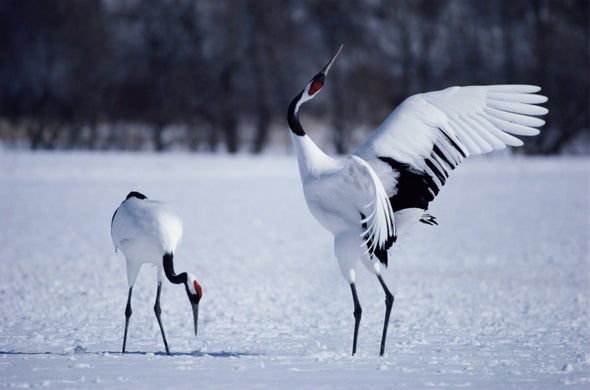(单词翻译:单击)
听力文本
This is Scientific American — 60-Second Science. I'm Karen Hopkin.
Monogamy. What makes one species pair off, while members of a closely related species play the field? The answer may lie in their genes.
Researchers at the University of Texas at Austin were interested in how complex characteristics arise during evolution.
"We chose to investigate this question using monogamous mating systems because animals with monogamous mating systems are available in all of the different vertebrate clades."
Rebecca Young, a research associate and evolutionary biologist, who led the study.
"And we were able to find species that had independently evolved monogamy in each of these lineages."
Young's colleague Hans Hofmann, professor of integrative biology, adds:
"So we decided early on that we didn't just want to study a particular group of animals, like mice or fish for example or a particular group of birds, and compare between monogamy or non-monogamy there. But instead take a very broad look across vertebrates, across 450 million years of evolution when these fish and birds and frogs and us shared the last common ancestor."
The researchers chose five pairs of species...and looked to see if they could spot a signature pattern of gene activity that was shared only by animals that were monogamous.
And they discovered a set of 24 genes whose activity in the brain is strongly associated with monogamy...including genes involved in neural development, learning and memory, and cognition. The results appear in the Proceedings of the National Academy of Sciences.

"And again this is surprising because they've evolved monogamy independently. And their, the species have diverged for hundreds of millions of years from one another. So we might expect because of this distance, evolutionary distance, that gene expression in the brain would be quite different. But in fact we find this shared signature that seems to be related to the mating system of the organism."
Now, those genes may not be setting up entirely new patterns of behavior. They may just be building on underlying mechanisms that all species share. Take for example, pair bonding.
"To form a pair bond, one has to tolerate another individual for a long period of time."
Yet, even members of the most intolerant species have to put up with one another...at least for as long as it takes to get the mating done.
"Shrews is a great example...so they tolerate each other for about one day a year. So those mechanisms already exist in very aggressive species. But they just happen for short periods of time. So we think potentially what's going on is modification of these conserved pathways that exist in multiple different kinds of mating systems get elaborated or modified in the evolution of monogamy."
In principle, Young and Hofmann and their collaborators could have extended the study of monogamy to humans...perhaps comparing our gene expression signature to that of our less monogamy relatives, say chimps. The results could suggest whether we should pick up a few ex's a card for Valentine's Day.
Thanks for listening for Scientific American — 60-Second Science. I'm Karen Hopkin.
参考译文
这里是科学美国人——60秒科学。我是凯伦·霍普金。
一夫一妻制。是什么让一个物种配对,而其近亲物种却脚踏多条船?答案可能在基因当中。
得克萨斯大学奥斯汀分校的研究人员想知道进化过程中是如何产生复杂特征的。
“我们选择用一夫一妻制来研究这个问题,因为所有不同脊椎动物进化枝的物种中都存在一夫一妻制。”
领导这项研究的助理研究员兼进化生物学家丽贝卡·杨说到。
“我们能在其中每个世系中找到独立进化出一夫一妻制的物种。”
杨的同事、综合生物学教授汉斯·霍夫曼补充说:
“我们很早就决定,我们不只是想研究一组特定的动物,比如老鼠或鱼或一组特定的鸟类,然后比较其一夫一妻制或非一夫一妻制。我们想广泛研究整个脊椎动物,跨越4.5亿年的进化过程,着眼于这些鱼、鸟和青蛙与我们人类有最后的共同祖先的时代。”
研究人员选择了五对物种,看看他们能否发现只有一夫一妻制动物才具有的基因活动的特征模式。
他们发现了一个由24个基因组成的基因组,其在大脑中的活动与一夫一妻制密切相关,这些基因涉及神经发育、学习和记忆以及认知。研究结果发表在《美国国家科学院院刊》上。
“这同样令人惊讶,因为它们独立进化出了一夫一妻制。这些物种已经彼此分离了数亿年。因此我们可以预想,由于这种进化距离,大脑中的基因表达可能会有相当大的差别。但事实上,我们发现这种共同特征似乎与生物体的交配体系有关。”
现在,这些基因可能没有建立全新的行为模式。它们可能只是建立在所有物种共有的潜在机制上。比如说“配对结合”。
“为了结合成一对,一方不得不长时间忍受另一方。”
然而,即使是最不能容忍的物种成员也不得不相互忍受,至少要忍受到完成交配。
“鼩鼱是个很好的例子,它们每年忍受彼此约一天的时间。因此,这些机制已经存在于极具进攻性的物种中。但这些机制的发生时间很短。所以我们认为,现在可能的情况是这些固有路径得到了修正,这些存在于多种不同交配体系中的路径,在一夫一妻制的进化过程中得到了完善和修改。”
原则上,杨和霍夫曼以及他们的合作者可以将这项一夫一妻制研究扩展到人类身上,也许可以将我们的基因表达特征,与一夫一妻制较弱的人类亲属(比如黑猩猩)的基因表达特征进行比较。研究结果可能会表明,我们是否应该在情人节时收下几位前任的卡片。
谢谢大家收听科学美国人——60秒科学。我是凯伦·霍普金。
译文为可可英语翻译,未经授权请勿转载!
重点讲解
重点讲解:
1. pair off (使)成对儿,(使)成双(常指成为恋人);
It seemed that all her friends were pairing off.
好像她的朋友全都成双结对了。
2. play the field 到处拈花惹草;滥交;
He gave up playing the field and married a year ago.
他不再处处留情,一年前结了婚。
3. diverge from 分叉;岔开;
Many species have diverged from a single ancestor.
许多物种都是同宗演变而来的。
4. put up with 忍受;容忍;
My girlfriend is a saint to put up with me.
能够忍受我,我的女朋友真的很有耐心。


